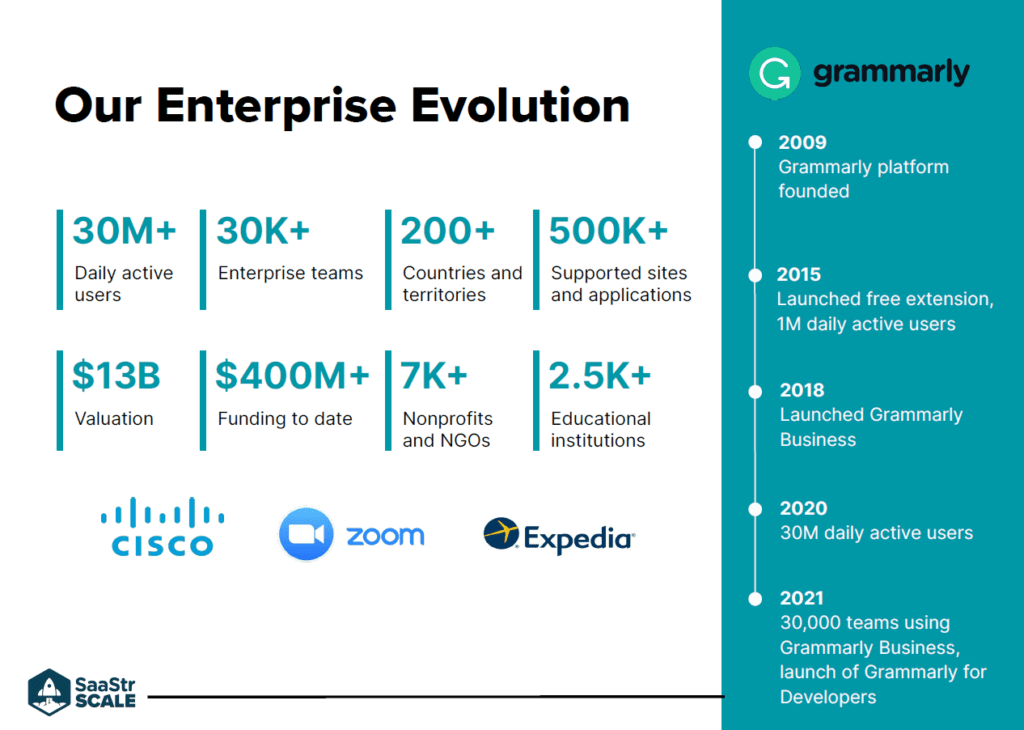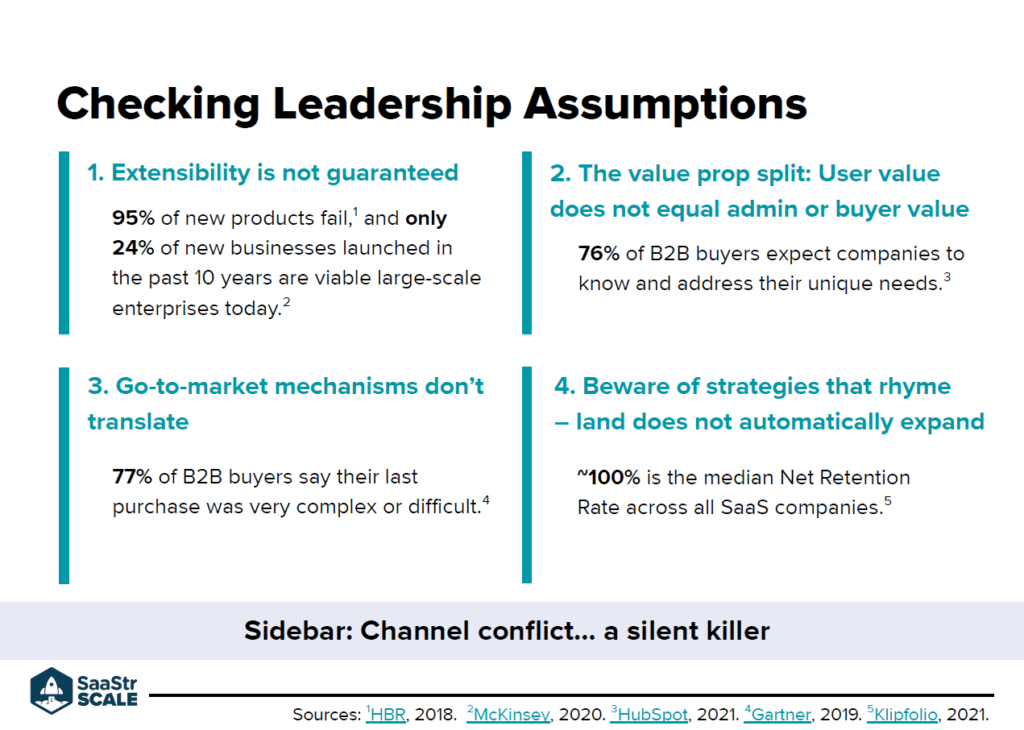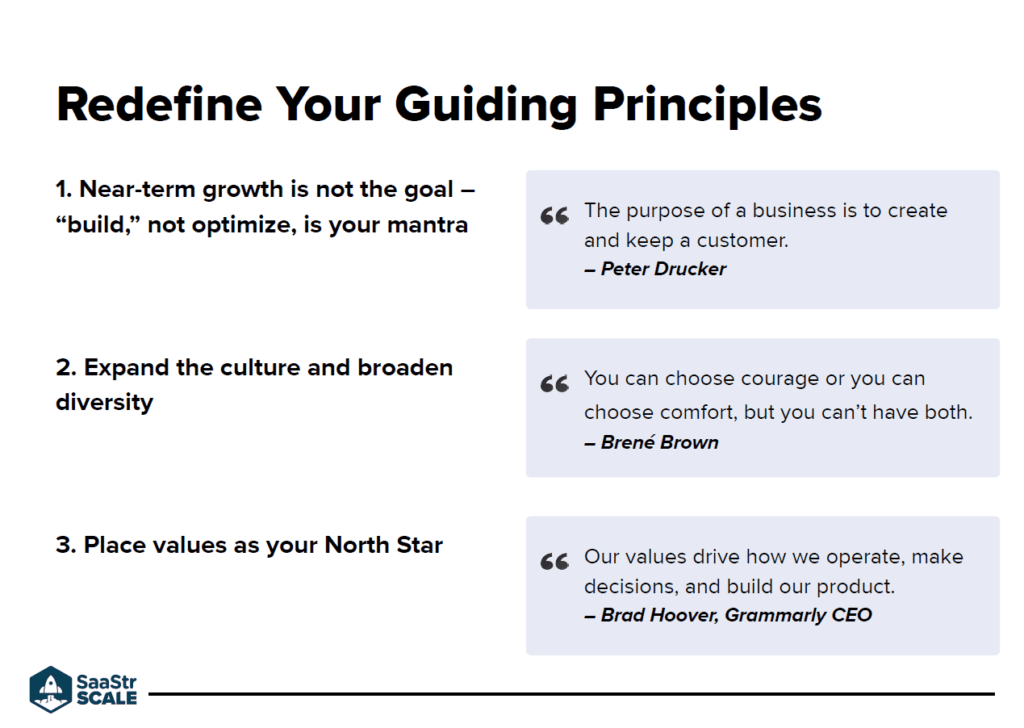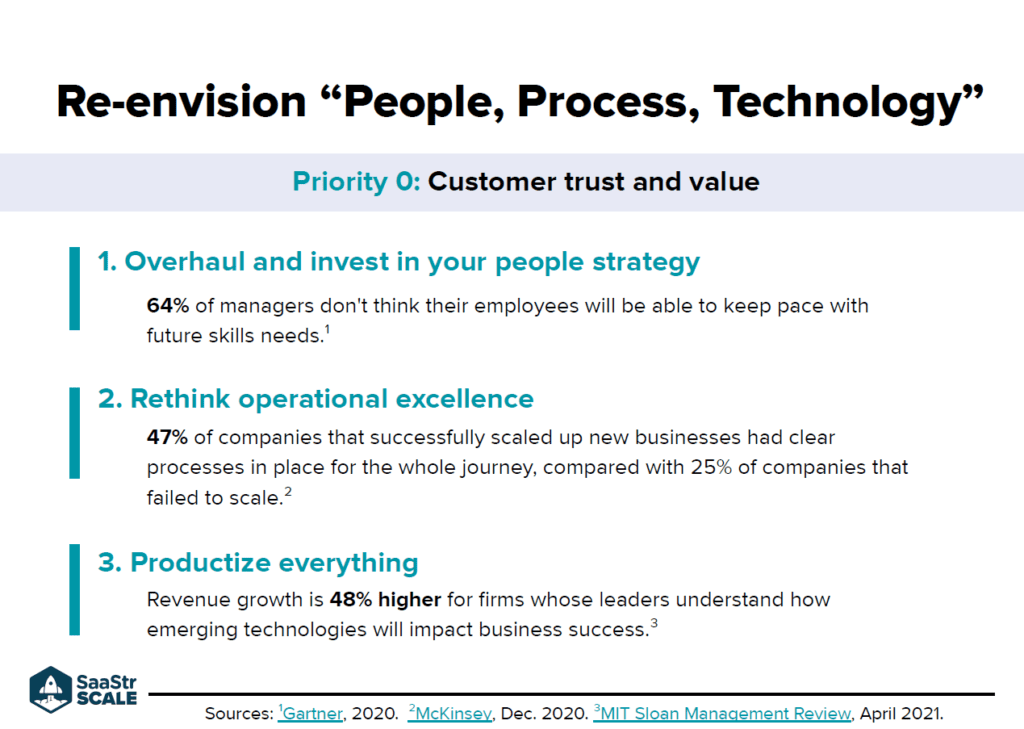If your organization is seeking growth in a new segment, like B2B—it will be a challenging ride because you’ll be in an unknown space. You might feel confused about where to begin, how to scale up, which mistakes you should avoid, and things you should consider before expanding.
Dorian Stone, Head of Organizations Revenue at Grammarly, is here to share lessons from his experience of scaling the company from consumer to SMB to Enterprise to help you steer your expansion efforts in the right direction.
Overview: Grammarly’s Enterprise Evolution

Grammarly was founded in 2009 and is a successful consumer product revolving around a virtual writing assistant that individuals and students use to write better content in their professional, educational, and personal lives.
Since its founding, Grammarly has grown to over 30 million daily users. Their offerings have expanded over the years from personal use to Grammarly Business, Grammarly for Non-Profits, and the recently launched Grammarly for Developers.
Now, let’s look at ten learnings that Dorian gathered while scaling Grammarly from a Consumer to an Enterprise brand with B2B offerings.
Want more? Enter your email below for the latest SaaStr updates

Build the baseline by checking leadership assumptions
The first set of learnings is about ensuring leaders don’t make implicit assumptions that come back and bite you later. It is important to be wide-eyed about some assumptions that can turn into pitfalls and hurt your growth early on.
When you’re looking for growth in new areas, you’re building off the success from where you’ve come from. Like when Grammarly scaled, they expanded from a consumer business. As a result, they made some incorrect assumptions that cost them valuable time and the opportunity to learn in the early stages of their efforts.
So, here are some assumptions you should look out for, while scaling up:
-
Extensibility is not guaranteed
Before Grammarly launched its Enterprise offering, they observed that many professionals brought the app to work. Naturally, they assumed their writing assistant was also applicable to the wider organizational processes. However, they were wrong about these assumptions, which kept them from identifying gaps and assessing the extensibility of their Enterprise product-market-fit.
Simply because their product was being used in a professional setting didn’t mean it was a product-market fit. Even when they launched Grammarly Business, they saw a lot of demand which distracted them from understanding where and when they should stop building off the extensibility of their consumer product and start looking at it from the Enterprise perspective.
If you’re making such an assumption, it’s better to double-check and save yourself from assuming you’re extensible and a product-market fit to a new audience based on your success in a different market.
-
Value prop split: User value doesn’t equal admin or buyer value
When you’re migrating from Consumer to SMB on your way to an Enterprise offering, it’s easy to overlook that buyers and users will be different people throughout this journey.
The admin, influential decision-makers, and consumer sales reps can be the same people in a Consumer or SMB setting. If not the same, they still might be tightly linked with shared responsibilities. But in an Enterprise setting, they will be very different people.
It’s essential to draw the line between users and buyers because your success in delivering value in the Enterprise area will depend on your ability to meet the needs of these two segments of your audience. You can consider the user and buyer the same in SMB, but as you migrate to a business setting, you’ll have to understand where your agendas should split between buyers and users over time.
-
Go-to market mechanisms don’t translate
From mechanisms and look and feel of the marketing campaigns to messaging and evaluation methods—everything works differently in Consumer and Enterprise.
For example, around two years back, Grammarly Business launched its first outbound campaign led by their B2C teammates. They were so accustomed to running tests in the market and seeing highly quantified results within two weeks that when they saw only a few B2B leads coming within the same period, they saw it as a failure. But the truth was, the campaign was performing above the benchmark, but it was a new area for them.
Avoid assuming that the go-to marketing mechanisms for your previous Consumer offering would translate in the Enterprise setting as well.
-
Beware of strategies that rhyme—land doesn’t automatically expand
We look at many organizations with robust expansion mechanisms and think we can do the same. But we make this assumption by only looking at their wins and fail to realize that despite strong foundations for scaling up, expansion doesn’t come naturally.
More than 50% of companies have negative net dollar retention metrics, so expanding because you’re under the assumption that it’ll be easy because others are successfully doing it can be a dangerous one and lead to a tricky organizational, economic structure.
Sidebar: Channel conflict
Migrating from a Consumer space, you have a consumer revenue line and a potential B2B revenue line to the extent that you have professionals moving from an individual product user to a B2B product user.
Amongst this, there can be a lot of conflicts in the middle of the organization around the operation and transition of the revenue line. Here, it’s crucial to make every team member realize that they’re rowing in the same direction.
Resolving this Consumer vs. Enterprise channel conflict will also help you learn a lot in the initial days without getting in your own way of optimizing for the short-term or siloed metrics rather than looking at the bigger picture.

Redefine your guiding principles
Setting some guiding principles before entering uncharted waters is vital to help you navigate an ambiguous path. Scaling up to Enterprise and B2B offerings differs completely from B2C operations.
Here are some principles you can lead with:
-
Near-term growth is not the goal—”build, not optimize” is your mantra
When Dorian stepped into his current role, they promised the board a strong growth on the revenue line. But after some digging in and introspection around the assumptions they had made, it was clear that they had to revisit and lead with a “build and learn” mindset rather than an optimized one.
However, it wasn’t easy to do this inside Grammarly, which was scaling in different directions, and where optimization was a massive driver for success.
Nevertheless, they shifted their mindset from having an established business to creating a new business for Grammarly Enterprise and getting customers from scratch.
-
Expand the culture and broaden diversity
There’s a lot of fear when you’re moving from a digital-led Consumer business to a business with multiple digital channels, sales channels, customer success channels, etc.
There may also be discomfort in the organization because earlier, everyone was used to following “one” successful way of doing things, which changes when you’re moving into a more qualified space like B2B.
Grammarly had to help people become comfortable and dedicated to the idea that the culture would evolve, just like they would. But for this, you need to have courage and instill it in your organization around the fact that expanding the culture, broadening the aperture, and thinking about diversity are important to build and scale the organization further.
-
Place company values as your North Star
At Grammarly, a set of values drives every decision, acting like the north star to tell team members if they’re operating, behaving, and thinking about the business in the right way. These values have also helped them navigate uncharted business territories, setbacks and move from one phase to another in the business.
It’s best to create a set of company values that can act as leading factors for significant decisions and difficult situations.
Re-envision people, processes, and technology
The way you process technology, hire people, and operate day-to-day will need to be changed and thought about differently as you venture into this new space.
As you move forward, it’s easy to be distracted, particularly if you’re feeling the pressure of growing or thinking about the best way to optimize for growth.
A Grammarly value that also translates into every operating decision they make is to bring value to the customers before thinking about their own revenue lines. They also ensure whatever they’re doing earns the right to have deep user and employee trust in an Enterprise setting—so businesses don’t just trust Grammarly but the institution as well.
But to operate this way, you need to re-envision how you look at hiring people and managing processes and technology.
-
Overhaul and invest in your people strategy
When investing in a team, task-relevant maturity is critical. Recalling the past couple of years working with his team, Dorian says a mistake he made was stretching people too far, outside of their area of expertise in the spirit of growing and challenging them.
But it’s important to hire the right team members with the right experience and pair pattern recognition and expertise with the right values to reach a higher bar for hiring.
Curiosity is a good candidate trait, but you can’t hire someone based on their curiosity or success at another organization alone. More than success, you want to invest in folks who bring experience and pattern recognition paired with curiosity and practical learnings from their past jobs.
-
Rethink operational excellence
In a scaled consumer business, operational excellence can mean being precise, getting things right, or being very thoughtful. But in a startup, you’ll want to fail fast, drive qualitative B2B information, and assess indicators and behaviors to learn from them rather than wait for the end state.
So, rethinking operation excellence and being thoughtful about your transition cycle from Consumer to Enterprise and how you operate within it is crucial as you move up the market.
-
Productize everything
As Grammarly traveled the journey of Consumer-MSB-Enterprise, they also had a growing side of the organization that complimented their product teams like sales, customer success, sales engineering, business development, sales development, and so on. This helped them market Grammarly Business to serve enterprises at scale effectively.
But as you expand and start productizing everything in your journey, it’s easy to get under the assumption that more headcount equals better performance.
In reality, it’s essential to ensure the leaders in those expanding areas of the organization share the same responsibility as the leaders on the product side of things—to drive productivity, productize things, and discover places where you can remove manual work from day one.
Dorian’s Top Takeaways for Expansion
- Assume your current strategy won’t work the way you want it to
Rather than taking an over-optimistic lens based on the momentum you saw with your previous offerings, lead with a critical and objective lens while maintaining a positive attitude about your growth.
- Focus on first creating customer value and reducing perceived work
All aspects of your business should focus on ways to add more value to the customers and make them more comfortable doing business with you. So, even when you’re extracting value and examples from a sales case, dig deeper and understand the customers’ needs to analyze the impact you’re going to have on them.
This will also help you achieve product-market fit faster and more effectively.
- Building the best foundation requires some of the least sexy work
When you’re making the transition to B2B, you will be pulled towards some shinier things like releasing features quickly or producing sales materials and assets. But before you get to them, it’s essential to get your operational basics right—which isn’t the sexiest work but is crucial for your successful expansion and growth.
- Invest in people with the relevant experience and values
It’s essential to invest in people with the right experience, backgrounds, and organizations you want to learn. Even more critical is to pair these virtues with the right values like curiosity and empathy to get a new value-add team member with the same vision as others in your organization.
- Reserve the right to be smarter tomorrow
Instead of trying to be smart today, reserve the time to be smarter tomorrow by putting all your learnings from yesterday into practice and empowering your team to do that too.
The post 10 Learnings Scaling from Consumer to SMB to Enterprise with Grammarly’s Head of Organizations Revenue Dorian Stone (Podcast 520 + Video) appeared first on SaaStr.
via https://www.aiupnow.com
Amanda Beaty, Khareem Sudlow

